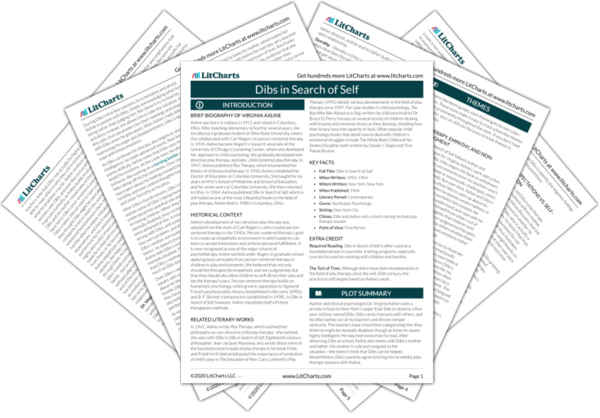Summary
Analysis
For the following week’s session, Axline borrows a city figurine set and leaves it in the room for Dibs to use if he wants. When Dibs arrives, he immediately notices the set and decides to build a toy town for himself. He sets up a church, a house, and a truck, describing his city as he builds it. Dibs also flies an airplane and sets up some stores, a hospital, and a garage. Next, he moves the mailman all over the city delivering letters, and he imagines a friendly farmer and his family in a house with their animals.
Dibs’s engagement with the figurine set not only illustrates his intelligence and creativity, but some of his newfound social skills, as well. This is clear from fact that he includes not only different objects, but friendly people as well. It’s apparent that his intelligence and social skills are now more balanced and that he has more trust in the outside world.
Themes
Dibs imagines a boy going into the river filled with alligators and snakes, but another child goes in after the boy and warns him to get into a boat. He says the two boys get into the boat together and become friends. Dibs also sets up a policeman directing traffic and a school. Dibs points out a little girl who will stay at home so she won’t be lonely. Dibs is excited about the city he has built.
Dibs’s imaginings here continue to illustrate higher emotional intelligence and improved social skills. He has sympathy for the little girl—who represents Dorothy—and indicates that he wants her to have a friend. With the alligator scenario, he acknowledges that friendship affords safety, whereas before connecting with others was anxiety-inducing for Dibs.
Themes
Suddenly, Dibs picks up the fire truck; he explains that one of the houses is on fire. The family is caught upstairs, he says, but the fire truck comes and rescues them. When he leaves his therapy session, he has to get his hair cut, and while he used to be afraid of the barber, he isn’t anymore. Dibs concludes, “I guess maybe I am growing up.”
Again, the comparison of these incidents to earlier sessions show how much Dibs has improved in a short period of time. He isn’t nearly as distressed by the imagined fire as he was a few sessions earlier, and he moves quickly to rescue the family, showing how his family relationships are healing. In addition, his description of the barber shows his improvement, as he grows more secure in himself and trusting of others.
Themes
Dibs sets up a few more figures in his city, and he designates one man as his father who is trying to get home. But, Dibs notes, the traffic sign always says stop and his father cannot get home. As Dibs leaves, he is excited about the world he built: “a world full of friendly people.” After Dibs is gone, Axline remarks that Dibs’s world was well-organized and his plan showed high intelligence. Dibs liked the people, though he still expressed resentment toward his parents. He is responsible and aware of his surroundings—he is certainly growing up, Axline thinks.
Here Axline affirms that Dibs’s emotional intelligence, social skills, and intellect are now more balanced. Because he views the city as having “friendly people,” he is able to use his intellectual capabilities and build a highly developed world. While he still expresses some discomfort with his father, he is able to express it in a much less aggressive way and work through those emotions.
Themes
Get the entire Dibs in Search of Self LitChart as a printable PDF.













